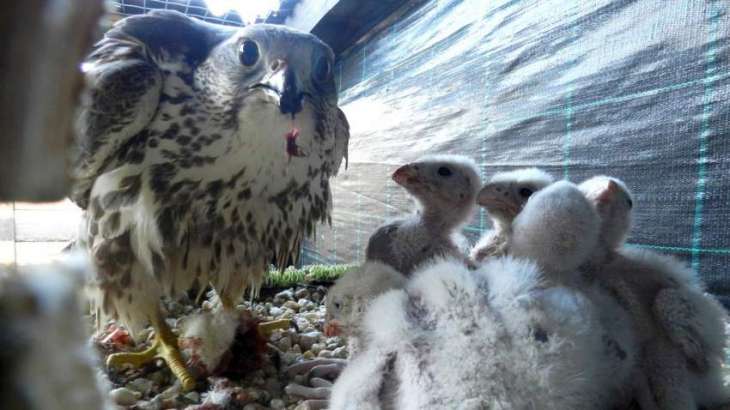Support for research and conservation projects on two bird species once believed to be extinct and another whose total population is believed to be as low at 50 are among newly-announced grants being made by the Mohamed bin Zayed Species Conservation Fund
ABU DHABI, (Pakistan Point News - 04th Jan, 2019) Support for research and conservation projects on two bird species once believed to be extinct and another whose total population is believed to be as low at 50 are among newly-announced grants being made by the Mohamed bin Zayed Species Conservation Fund.
One, the Jerdon’s Courser (Rhinoptilus bitorquatus) was first recorded by a British surgeon, Thomas Jerdon, in 1848 in the Eastern Ghats of what is now the Andhra Pradesh district of India, being seen occasionally over the next few decades until 1900. With no more sightings being made, it was believed to be extinct until a study by the Bombay Natural History Society and the US Fish and Wildlife Service re-discovered it in 1986 in an area promptly designated as a wildlife sanctuary.
A few more sightings followed, but the species has not been seen since 2009, despite dedicated searches between 2010 and 2015. Today, it is one of the rarest birds in the world. Jerdon's Courser is listed by IUCN as Critically Endangered, meaning that it is facing a very high risk of extinction. Its preferred habitat becoming increasingly scarce and fragmented, due to fuel-wood collection, livestock grazing, quarrying and clearance for agriculture and plantations. As few as 50 may survive.
A Species Recovery Plan has been developed that includes research, monitoring, conservation education and habitat management to ensure its long term survival. Current research is being managed and conducted by Bombay Natural History Society, BNHS, along with Britain’s Royal Society for the Protection of Birds, RSPB, and the Universities of Reading and Cambridge, supported by the Darwin Initiative and the Andhra Pradesh Forest Department.
Research into another bird once believed to be extinct, the Bermuda Petrel or Cahow, (Pterodroma cahow),the national bird of the island archipelago of Bermuda, is also receiving support from the Fund. The species was numerous prior to the arrival of European ships at the end of the 15th Century, with an estimated half a million pairs nesting. Thanks to the introduction of rats, cats, pigs and dogs over the next century by settlers, as well as the destruction of the natural habitat, numbers plummeted and the species was presumed extinct by around 1620. The species was not seen again until 1906, with a couple more being seen in 1935 and 1941, before a tiny breeding colony of 18 pairs was found in 1951.
Since then, an intensive conservation programme, which has included the eradication of rats from the offshore islets on which it still breeds, has seen numbers rise to around 115 breeding pairs.
According to Dr. George Wallace, Vice President for Oceans and Islands for the conservation organisation American Bird Conservancy, which has been actively engaged in work to protect the Bermuda Petrel, "This has been an amazing success story that involves the same kinds of issues we see in many island locations when new species of predators and/or grazing animals are introduced to delicately balanced island ecosystems. The predation and impacts to habitat can be devastating, and have caused countless species to go extinct around the world. The Cahow recovery project is a great example of how these threats can be overcome."
A third species, the Fatu Hiva monarch (Pomarea whitneyi) is a large flycatcher which is confined to the small island of Fatu Hiva in the Marquesas Islands in French Polynesia in the South Pacific. It lives in the native dense forest at elevations up to 2300 feet.
In February 2000, the total population was estimated at a few hundred pairs but by 2011 numbers were estimated to have fallen to as low as 50 individuals, probably because of the arrival of rats on the island in 2000. Predation by cats also poses a threat to the survival of the species. Thanks to an intensive programme to eradicate rats, the population of Fatu Hiva monarchs has now begun to increase slowly, but it remains one of the most endangered species of birds in the world.
In its latest round of grants, the Mohamed bin Zayed Species Conservation Fund is also supporting a project devoted to another petrel species, the Black-capped petrel, (Pterodroma hasitata), a close relative of the Bermuda Petrel, with four known colonies in Haiti, the Dominican Republic and the island of Dominica, in the Caribbean. Funds are being given for satellite-tagging to study the movements of the birds at sea. Support is also being given for work on the conservation of the African white-backed vulture, (Gyps africanus), in Tanzania. Once one of Africa’s most common vultures, it is now classified as Endangered by IUCN, because of widespread poisoning of animal carcasses.
Established in 2008, with an endowment from His Highness Sheikh Mohamed bin Zayed Al Nahyan, Crown Prince of Abu Dhabi and Deputy Supreme Commander of the UAE Armed Forces, the Mohamed bin Zayed Species Conservation Fund has so far given a total of just over US $ 18 million to 1,924 conservation projects, covering over 1,200 species and sub-species of plants and animals.




